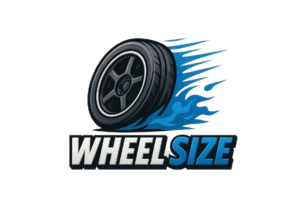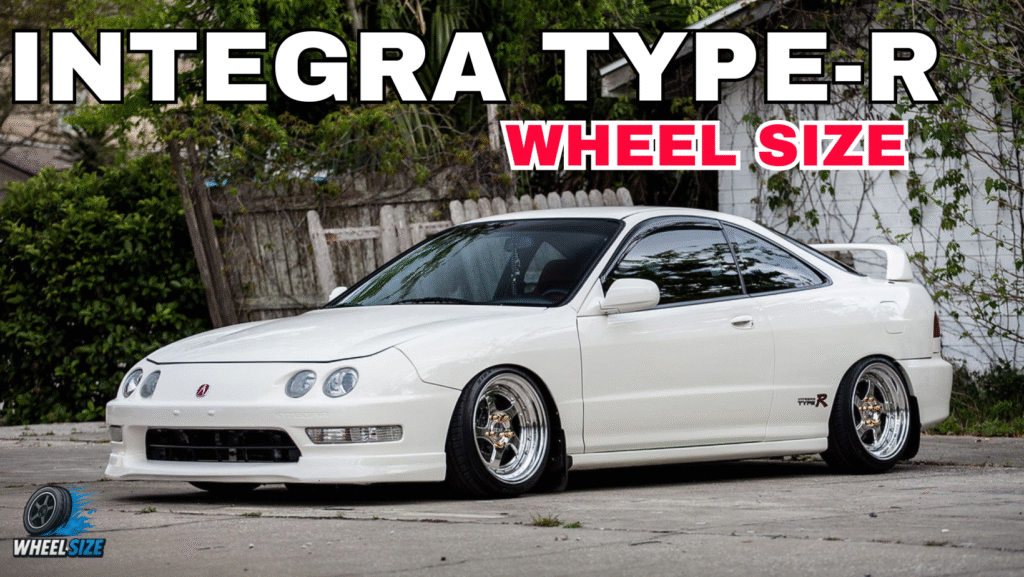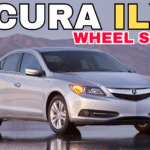Introduction
The Acura Integra Type-R (1997–2001) is one of the most famous performance cars with front-wheel drive. This limited-production car was a real track weapon because of its race-inspired engineering and light chassis. If you want to keep its performance or improve its stance, you need to know how to install the wheels correctly. Every detail, from bolt patterns to offset, has a big effect on how your Integra handles and performs. We’ll go over the exact wheel fitting for each model year in this guide, so you won’t have to guess which wheels will fit your car. This guide includes everything you need, whether you’re fixing up an old car or getting ready for the next track day.
Read About: Acura ILX Wheel Fitment Guide
Acura Integra Type-R Wheel Specs Overview
All Acura Integra Type-R vehicles sold in the U.S. between 1997 and 2001 had the same wheel layout. The wheel bolt pattern is 5×114.3 for all years, which works well with a lot of aftermarket parts. The typical rim size is 15×6 inches with a +50mm offset. This keeps the ride tight and responsive. The hub bore is 70.1 mm, which makes sure it fits snugly over the wheel hub for better balance. The factory-installed tires were 195/55R15, which provide a good balance of traction and ride quality. These requirements maintain the suspension geometry the same and don’t cause any clearance problems. People who are really into cars typically get bigger wheels, like 16″ or 17″. But it’s vital to stay within a +35 to +50mm offset range and not go too wide, especially if you don’t want to roll your fenders. If you know these essentials, you can be confident that your fitment will be tidy and functional while still giving you the real Type-R driving sensation.
Acura Integra Type-R DC [1997–2001]
| Year | Center Bore | Bolt Pattern | Lug Nut Thread | OEM Tire Size | OEM Rim Size | OEM Offset Range (mm) | Tire Pressure (Front / Rear, bar) | Aftermarket Wheel Size Range |
| 1997 | 64.1 mm | 5×114.3 | M12 x 1.5 | 195/55R15 84V | 6Jx15 ET50 | 48–52 | 2.3 / 2.1 | 15″–16″ |
| 1998 | 64.1 mm | 5×114.3 | M12 x 1.5 | 205/45R16 84V | 6.5Jx16 ET55 | 48–52 | 2.4 / 2.2 | 16″–17″ |
| 1999 | 64.1 mm | 5×114.3 | M12 x 1.5 | 215/40ZR17 84W | 7Jx17 ET48 | 48–52 | 2.4 / 2.2 | 17″–18″ |
| 2000 | 64.1 mm | 5×114.3 | M12 x 1.5 | 195/55R15 84V | 6Jx15 ET50 | 48–52 | 2.3 / 2.1 | 15″–16″ |
| 2001 | 64.1 mm | 5×114.3 | M12 x 1.5 | 205/45R16 84V | 6.5Jx16 ET55 | 48–52 | 2.4 / 2.2 | 16″–17″ |
1997 Acura Integra Type-R Wheel Fitment
The first Acura Integra Type-R to be sold in the U.S. came out in 1997. It had 15×6 inch alloy wheels and 195/55R15 tires. These 5-spoke rims were light and helped the Type-R handle like a pro. The tires had the right amount of grip and comfort, and the sidewalls were thick enough to handle small bumps in the road without affecting performance. We chose this setup very carefully to work with the car’s tuned suspension and limited-slip differential, which makes it feel precise and quick in turns. It’s best to go with this original mix if you’re keeping your 1997 model close to OEM specs.
The Integra Type-R from 1997 has a bolt pattern of 5×114.3, an offset of +50mm, and a center bore of 70.1 mm. These criteria make sure that the wheels fit precisely with the factory hub and suspension geometry. The high positive offset draws the wheels in, so they don’t touch the fenders when you turn sharply. The 70.1 mm hub bore lets the wheel rest flush without needing centering rings. When you convert to aftermarket wheels, it’s important to make sure these measurements are the same so that the Type-R stays aligned, doesn’t vibrate, and keeps its great handling.
The 1997 Integra Type-R can fit 16×7 or 17×7 wheels without needing a lot of work. To keep the best suspension clearance, aim for offsets between +38mm and +45mm. To avoid rubbing, keep the tire width at 205 for a square setup. Don’t utilize offsets that are too low since they could produce problems with the fender or wear out the tires too quickly. If you want better performance, lightweight forged wheels are the way to go. If you want more stylistic options, cast wheels are the way to go. Always think about the extra weight and how it can change how fast you can go and how comfortable your ride is.
1998 Acura Integra Type-R Wheel Fitment
The 1998 model had the same factory setup as the one before it, with 15×6 inch wheels and 195/55R15 tires. These wheels were light and made to lower the car’s unsprung weight, which made it respond faster to changes in the road. The height of the tire sidewall made the automobile comfortable on the road but strong enough to handle sharp turns. If you’re fixing up a 1998 Type-R, getting these OEM wheels will help the car stay true to how it was meant to perform.
The fitting parameters stayed the same from 1997 to now: the bolt pattern was still 5×114.3, the offset was still +50mm, and the hub bore was still 70.1 mm. Because of this, it’s easy to switch wheels between model years without worrying about whether they will fit. Still, it’s important to double-check the offset when you buy aftermarket wheels, especially if they’ve been used on other platforms. Keeping that +50mm requirement or something close to it is important for keeping the wheels in the right position and stopping them from wearing down too soon.
Recommended Upgrades and Spacing Considerations
If you want your 1998 Type-R to look more aggressive or have a wider stance, 16×7 wheels with 205/50R16 tires are an excellent choice. Some owners choose 17×7 wheels with 205/45R17 tires for a more stylish look. In either instance, stay between +40mm and +45mm to keep from rubbing. You normally don’t require spacers unless your wheels have a higher offset. Always upgrade your wheel studs to keep them safe if you utilize spacers.
2000 Acura Integra Type-R Wheel Fitment
Acura preserved the tried-and-true 15×6 inch wheel and 195/55R15 tire combination until 2000. The white polish on these wheels set the Type-R apart from other Integra grades. This size was still perfect for keeping the car’s ride balance and quick handling. The car’s small frame and compact wheel width work well together to keep it agile. Even while it may look little by today’s standards, this size is still great for both everyday driving and track days.
The 2000 model used the same 5×114.3 bolt pattern, +50mm offset, and 70.1 mm hub bore as models from previous years. Because all the years are the same, it’s easy for fans to switch out or rotate wheels without having to rethink the whole fitting calculation. Always check that your wheels meet these specs, whether you’re upgrading or keeping the same ones. If not fixed, misaligned offsets or wrong hole sizes can cause vibrations, uneven wear, and even safety problems.
Performance Wheel Setup Suggestions
Want to make your 2000 Type-R run better? Think about using 205/50R16 tires with 16×7 lightweight wheels. This combination gives you extra grip while keeping the weight of the wheels in check. Some drivers use 17×7 wheels with 215/45R17 tires for a more aggressive look, but this makes the fender clearance narrower. When you make the wheels bigger, always keep an eye on the suspension travel. If you want the best lap times or an aggressive street stance, lowering springs and camber kits might help you get the right fit.
2001 Acura Integra Type-R Wheel Fitment
The last year of the U.S. Acura Integra Type-R still had 15×6 wheels and 195/55R15 tires, which made this combination the factory standard. The white-painted rims went well with the car’s Championship White body, giving it a sporty appeal. The car’s original handling was kept with this setup, which kept it light on its feet and balanced through turns. These OEM wheels are still popular among purists who wish to keep the factory specs.
The 2001 Type-R has the same bolt pattern (5×114.3), offset (+50mm), and hub bore (70.1 mm) as the older variants. When you buy new wheels, make sure they match these measurements to avoid problems like brake caliper contact or uneven tire wear. You can make changes, but sticking to these original proportions will help keep the car’s unique driving experience. If you’re not sure, put the wheels on the car before putting the tires on to make sure everything fits.
Ideal Plus Sizing Options
16×7 wheels with 205/50R16 tires are a wonderful option if you want to change the look of your car without making it harder to drive. They provide you more grip without making the steering less responsive. If you want to make your car look even sportier, you may get 17×7 wheels with 215/45R17 tires. Just be careful not to lower the car too much, otherwise it can rub. Before making a final selection, always verify the inner clearance and suspension travel.
Best Tire Sizes for Acura Integra Type-R (1997–2001)
If you want to keep the factory ride quality and handling, it’s always a good idea to stick with the OEM tire size of 195/55R15. It’s the right size for all four model years, and it keeps your speedometer correct. 205/50R16 and 215/45R17 are two frequent plus-size alternatives that boost grip and steering accuracy without changing the shape of the car too much. You can put wider tires like 225 on wheels that are 7.5″ or 8″ wide, but you may need to roll the fenders or change the camber. When changing tire sizes, always think about the height and alignment of the suspension. Rotating your tires often and having the right amount of air in them will help them last longer and work better.
Recommended Aftermarket Wheel Sizes
For people who want to go beyond stock, the Integra Type-R reacts well to small changes. People who like to drive fast like 16×7 wheels, while 17×7 or 17×7.5 wheels give the car a more aggressive look. To maintain the wheels flush without rubbing, use offsets between +38mm and +45mm. The weight of the wheels is also important. Lighter wheels lower the unsprung mass, which makes the ride better and speeds up. There are high-performance choices from brands like Enkei, Volk Racing, and RAYS that go well with the Integra’s style. Just make sure there is enough space for the brakes and pick wheels that are hub-centric or use the right rings to keep them from vibrating. This keeps your ride smooth and your wheels securely attached.
Common Fitment Issues and Solutions
The Integra Type-R is rather forgiving when it comes to changing wheels, but there are some things you should stay away from. Fender rubbing is the most typical problem, especially when using bigger wheels or lower offsets. Rolling the fenders or changing the camber settings can fix this. Another worry is utilizing wheels with the wrong center bore, which might make the car shake. If you need to, use hub-centric rings. Always make sure that your wheel studs have enough thread engagement when you use spacers. Also, lowering your suspension can change how far you can go and how much space you have, so be sure to test fit everything. Stay away from cheap, big wheels that make your suspension heavier and more stressed. If you stick to high-quality parts and do your research on sizing, your Type-R will drive the way it should.
Conclusion
The wheels you choose for your Acura Integra Type-R don’t only change how it looks; they also have a big impact on how it handles, how safe it is, and how fun it is to drive. Every detail is important, from the factory 15×6 arrangement with a 5×114.3 bolt pattern and +50mm offset to carefully chosen aftermarket choices. You can keep the Type-R’s famed balance while adding your personal touch by knowing the fitment specifications for each year and staying within the known size ranges. This article teaches you the basic information you need to do it well, whether you want to restore it to showroom condition or make it even better.
FAQs
Q1: What is the bolt pattern for the Acura Integra Type-R?
All model years (1997–2001) use a 5×114.3 bolt pattern.
Q2: Can I fit 17-inch wheels on my Type-R?
Yes, 17×7 wheels with 215/45R17 tires work well, but watch for fender clearance if lowered.
Q3: What’s the safest offset range for aftermarket wheels?
Stick between +38mm to +45mm to avoid clearance issues and maintain good handling.
Q4: Do I need hub-centric rings for aftermarket wheels?
Only if the wheels don’t match the 70.1 mm center bore. Hub-centric rings ensure a tight fit and prevent vibrations.



